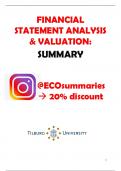Summary
Financial Statement Analysis & Valuation - Summary - Tilburg university - MSc Finance / Accounting
- Course
- Institution
Instagram: ECOsummaries DM me for 20% discount! Summary for the course 'Financial Statement Analysis & Valuation'. This summary was written in order to study for the final. Everything you need to know is available in this summary. Instagram: ECOsummaries DM me for 20% discount!
[Show more]




